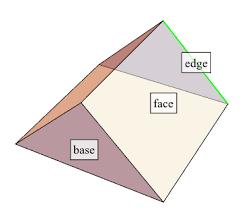Perpendicular 3146
The base of the vertical prism is a right triangle with a perpendicular 5 cm. The area of the largest wall is 130 cm2, and the body's height is 10 cm. Calculate the surface area of the body.
Final Answer:

Tips for related online calculators
See also our right triangle calculator.
You need to know the following knowledge to solve this word math problem:
arithmeticsolid geometryplanimetricsGrade of the word problem
Related math problems and questions:
- Triangular prism
 The base of the perpendicular triangular prism is a right triangle with a leg length of 5 cm. The area of the largest sidewall of its surface is 130 cm², and the body's height is 10 cm. Calculate its volume.
The base of the perpendicular triangular prism is a right triangle with a leg length of 5 cm. The area of the largest sidewall of its surface is 130 cm², and the body's height is 10 cm. Calculate its volume. - Triangular prism
 The perpendicular triangular prism is a right triangle with a 5 cm leg. The prism's largest wall area is 130 cm2, and the body height is 10 cm. Calculate the body volume.
The perpendicular triangular prism is a right triangle with a 5 cm leg. The prism's largest wall area is 130 cm2, and the body height is 10 cm. Calculate the body volume. - Perpendicular 35183
 Calculate the surface and volume of a vertical prism if its height h = 18 cm and if the base is an equilateral triangle with side length a = 7.5 cm.
Calculate the surface and volume of a vertical prism if its height h = 18 cm and if the base is an equilateral triangle with side length a = 7.5 cm. - Perpendicular prism
 Calculate the volume of the vertical prism if its height is 60.8 cm and the base is a rectangular triangle with 40.4 cm and 43 cm legs.
Calculate the volume of the vertical prism if its height is 60.8 cm and the base is a rectangular triangle with 40.4 cm and 43 cm legs. - 3sides prism
 The base of a vertical prism is an isosceles triangle whose base is 10 cm, and the arm is 13 cm long. The prism height is three times the height of the base triangle. Calculate the surface area of the prism.
The base of a vertical prism is an isosceles triangle whose base is 10 cm, and the arm is 13 cm long. The prism height is three times the height of the base triangle. Calculate the surface area of the prism. - Perpendicular 79804
 A perpendicular hexagonal prism was created by machining a cube with an edge length of 8 cm. The base of the prism is created from the square wall of the original cube by separating 4 identical right triangles with overhangs of lengths 3cm and 4cm. The he
A perpendicular hexagonal prism was created by machining a cube with an edge length of 8 cm. The base of the prism is created from the square wall of the original cube by separating 4 identical right triangles with overhangs of lengths 3cm and 4cm. The he - Perpendicular 3482
 The lengths of the base legs are 7.2 cm and 4.7 cm, and the height of the prism is 24 cm. Calculate the volume and surface of a triangular perpendicular prism with the base of a right triangle.
The lengths of the base legs are 7.2 cm and 4.7 cm, and the height of the prism is 24 cm. Calculate the volume and surface of a triangular perpendicular prism with the base of a right triangle.
